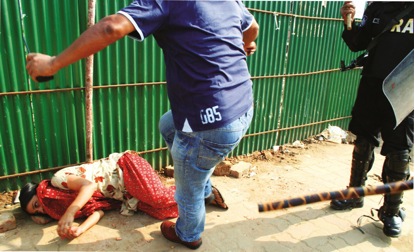Subscribe to ShahidulNews
Women's Empowerment and State Repression
By Rahnuma Ahmed
If women's empowerment is a progressive mainstream agenda, then why aren't the struggles of women garment workers for living wages and safe and secure working conditions, not solidly a part of larger progressive movements being waged in Bangladesh? Movements which struggle to democratise state and society, to re-construct gender relations on equitable lines. It is a question that is not only worth raising, it is urgent that we raise it, that we seek answers to it. It is vital that progressive women's organisations, writers, intellectuals, journalists, academics, actors/actresses, artists, musicians, song-writers, salaried persons, entrepreneurs, youth organisations, civil society forums etc., etc., confront the question, that they engage with it both as individuals, and as organised collectivities. It is a question which should no longer be avoided, nor should it be silenced. However, in most progotisheel circles, the question is not formulated in this manner. But I see no reason for this, as mainstream progressive circles define themselves?in opposition to those whom they deem conservative or reactionary?through avowing their commitment to democratic ideals, central to which is the status of women, and their role in society. Central to it, is also the dichotomous idea that society is divisible into two types, traditional vs. modern(ising) societies, which co-exist within the same country, within the same nation-state. The idea that, leaving behind rural society and taking up waged employment in the formal sector of the economy opens up windows of opportunities for women: it enables them to break free from the patriarchal family. It creates the conditions for the emergence of new forms of femininities; women who are conscious of their legal rights, are integrated into the public domain, are consumers on equal terms with men (since the market offers `freedom of choice'). That these processes, in short, enable the transformation of women?lumped as backward, as an undifferentiated mass?into social citizens worthy of a modernising nation-state. Mainstream accounts of the garment industry, as well as individual life-stories of its predominantly female workforce, is being written broadly along these lines. Through repeated assertions, this `history in the making' narrative has become almost common-sensical, at least, among the educated sections of society, among those who view themselves as being forward-looking, and forward-thinking. As being society's natural leaders. By drawing literally millions of women from villages to cities, the ready-made garment sector (RMG), has caused a `silent' revolution. It has transformed a way of life that had remained "unchanged for generations" (Syed Zain Al-Mahmood, The Star Weekend Magazine, March 19, 2010). It has provided millions of women from poorer backgrounds with employment opportunities, a `happening' that is unprecedented in the history of Bangladesh, and further back, when the landmass and its people, were part of Pakistan, or much earlier, when it was part of the British empire. In late 19th to early 20th century Bengal, women had become part of the industrial labour force by taking up work in the jute mills of Calcutta, but at its highest, their participation was 17-20% of the total workforce (Samita Sen, Women and Labour in Late Colonial India. The Bengal Jute Industry, 1999) whereas, in contemporary Bangladesh, more than three-quarters of the estimated three and a half million strong who work in the RMG sector, which accounts for 75-80% of annual export earnings, consist of women. Waged incomes for women working in the garment sector, says BIDS researcher Pratima Paul Majumdar, is comparable to "the difference between life and death." In a poverty-stricken country like Bangladesh, women, as members of a patriarchal society, did not have access to resources or opportunities to "improve" their situation. They did not have a say in "decisions concerning their lives" (Swapna Majumdar, Bangladesh Garment Workers Have Taste of Freedom, July 15, 2002). Traditional norms dictated that women should reside under the tutelage of a male guardian, but these have been broken as families have increasingly allowed their daughters to migrate to cities, to share rooms with other female garment workers. Many women have become the principal earner in their families, it has helped boost their self confidence, it has empowered them to make decisions about how to spend their incomes. A survey conducted by Nari Uddog Kendra reveals changes in the domestic division of labour: husbands of garment working women who are the principal breadearners, are more likely to take care of all domestic chores. Marrying later has meant delayed childbearing, and a decrease in fertility. Paul Majumdar's study indicates changes in the average age at which women give birth to their first child, 17 years in 1991, 22 years in 2000. An independent source of livelihood has "changed this conservative Muslim country's society in immeasurable ways," writes Vikas Bajaj (The New York Times, July 21, 2010). New female subjectivities, new views about life, new ideas of self-worth. Twenty one year-old Maasuda Akthar married a man she met at the factory, later, turned down his offer of leaving her job for a more comfortable life at home, she does not plan to have children soon. Majeda Begum, 38 year-old, says, she wants her daughter to "study as much as she wants," to not force her into marriage like she herself. Surely there is nothing regressive in these social changes, nothing that should cause alarm among those who identify themselves as being progressive? On the contrary, for one of the cornerstones of the progressive identity of the Bengali Muslim middle class, historically forged during the colonial period, was resistance to female seclusion. Part of the silent revolution initiated by female employment in the garment sector has been women's increased "visibility ": women are no longer content to live "a life of anonymity behind their purdahs, or veils." Cultural norms requiring girls "to cover their faces" and "extremely restricted" mobility puberty-onwards, have broken down. Selim Nawaz, owner of Texmark, describes the silent revolution thus, "Thousands of women in their late teens and early 20's are wearing cosmetics, carrying handbags and walking to work [i.e., are visible] every day. They are empowered in a modest way." Factory owners discourse, and all those who speak for global capital, whether thinkingly or unthinkingly, and this, in my view, includes mainstream progressives, overlooks the misery of workers. They choose to ignore, as Jeremy Seabrook writes movingly, that living in the city does not broaden the horizons of garment workers (Bangladesh's Rioting Garment Workers, August 2010). "If anything, the wide skies and ferocious cyclones that devour land and flood crops tell them more about the world than their twilit factory experience." House rents gobble up half of their wages, "home is a windowless room in a concrete building shared with five others or a sweltering hutment of tin. The urban poor are being compressed into a declining area of the city, while factories, palaces blazing with light, tower over slums and tenements." Their diet consists of rice, dal and vegetables, no meat, eggs, fruit or milk. Their stories speak of "unreliable water supplies, long queues for the latrine, sweaty nights under roofs that retain the heat of the day, youth and energy sewn into throwaway garments, made with a Juki machine on a plastic-topped table under shadowless strip lighting." [caption id="attachment_9506" align="aligncenter" width="415" caption="A plainclothed policeman stamping on a garment worker during the blockade of Bishwa road at Kuril in Dhaka. Sanaul Haque, New Age "] [/caption]
[caption id="attachment_9509" align="aligncenter" width="187" caption=" Bangladesh, the big four world apparel exporters"]
[/caption]
[caption id="attachment_9509" align="aligncenter" width="187" caption=" Bangladesh, the big four world apparel exporters"] [/caption]
[/caption]
While the left alliance of 14 garment workers' associations insisted that minimum wage should be fixed at 5,000 taka, government-backed unions acceded to 3,000 taka in July. Protests broke out again when many factories failed to implement what had been agreed upon, or implemented it through applying a grading system which effectively lessened the pay of many workers. Nothing new, for, according to a news report (Ittefaq, May 31, 2006), factory owners? associations had till then signed 22 agreements with their workers, none of which had been implemented (Karmojibi Nari, Implement the Agreements). Factory owners allege that worker protests are caused by "outside agitators or dim-witted workers who don't understand the complexity of international trade" (newredindian, August 2, 2010). But, Farida Sheikh argues, an analysis of media reports indicate that providing minimum wage rate will hardly hinder the profit-margin. In the financial year 2010, a pay rise would have resulted in 1.0-3.0% increase in the cost of garment products whereas the average profit margin was 8.0-10 % of export value. According to World Bank economic report, RMG exports nearly doubled in the last five years, from $ 6.4 bn, to 12.3 bn. (Death ?murder of a garment worker! The Financial Express, August 10, 2010). At this particular moment of our neo-liberal existence, progressive forces, and the rest of the nation, are faced with two contrasting images of femininity, as captured by the photos on this page. One shows a plainclothed policeman, clutching a walkie-talkie with arm extended, to stomp with greater force on the young woman lying helplessly on the ground, snapped during garment worker protests at Kuril last year. The other, and it is images such as these that stare at us from the pages of dailies and weeklies, and from TV screens, which seem to proclaim a different kind of female empowerment. Western feminists have anxiously noted how meanings of empowerment have shifted for younger women, how earlier emphases on social change and liberation have given way to individualised empowerment, constructed as personal choice or individual equality, how this has accompanied a highly visible shift in popular culture which deliberately re-sexualises and re-commodifies women's bodies. ?I am not sure why, but I am reminded of these concerns when I look at the second picture. I am also reminded of electoral manifestos, of the ruling Awami League's pledge that food rations will be introduced for all labourers including garment workers. Pledges unkept, two years on. And interestingly enough, of Jamaat-e-Islami Bangladesh's manifesto, pledging the introduction of a minimum wage structure and `equal pay for men and women,' the provisioning of personal, financial and social security for female labourers, including garment workers. I cannot fail to wonder why mainstream progressive forces do not raise questions about why women, who belong to the majority, who have initiated a silent revolution in Bangladesh are attacked and stomped upon by law-enforcing agencies of the state. Why those who represent and fight for securing decent wages for garment workers, such as Moshrefa Mishu, president of the Garment Workers Unity Forum, is arrested and remanded, is threatened with dire consequences if she refuses to sign blank sheets, is also informed that she would have been `disappeared' if the media had not quickly broadcast news of her having been picked up (Asian Human Rights Commission). The ruling class, and this includes 45 members of parliament who are factory owners, promote images of femininity which make us forgetful of other images. Of brutality, of repression, whether by hired thugs and goons, or those belonging to the law-enforcing agencies. If progressive forces, particularly women's organisations who claim to represent all women of Bangladesh, remain deluded and persist in ignoring the struggles of women garment workers, it is not unlikely that they will become irrelevant. To the majority of women. Published in New Age, Monday January 24, 2011





Leave a Reply
You must be logged in to post a comment.